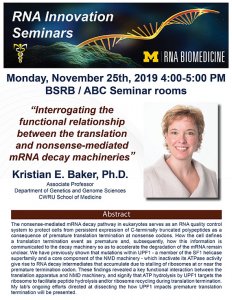Presented By: Center for RNA Biomedicine
RNA Innovation Seminar, Kristian Baker, Case Western
“Interrogating the functional relationship between the translation and nonsense-mediated mRNA decay machineries”

Kristian E. Baker, Ph.D. (Principle Investigator), Center for RNA Molecular Biology, Case Western Reserve University
Abstract: The nonsense-mediated mRNA decay pathway in eukaryotes serves as an RNA quality control system to protect cells from persistent expression of C-terminally truncated polypeptides as a consequence of premature translation termination at nonsense codons. How the cell defines a translation termination event as premature and, subsequently, how this information is communicated to the decay machinery so as to accelerate the degradation of the mRNA remain unclear. We have previously shown that mutations within UPF1 - a member of the SF1 helicase superfamily and a core component of the NMD machinery - which inactivate its ATPase activity give rise to RNA decay intermediates that accumulate due to stalling of ribosomes at or near the premature termination codon. These findings revealed a key functional interaction between the translation apparatus and NMD machinery, and signify that ATP hydrolysis by UPF1 targets the ribosome to facilitate peptide hydrolysis and/or ribosome recycling during translation termination.
My lab’s ongoing efforts directed at dissecting the how UPF1 impacts premature translation termination will be presented.
Abstract: The nonsense-mediated mRNA decay pathway in eukaryotes serves as an RNA quality control system to protect cells from persistent expression of C-terminally truncated polypeptides as a consequence of premature translation termination at nonsense codons. How the cell defines a translation termination event as premature and, subsequently, how this information is communicated to the decay machinery so as to accelerate the degradation of the mRNA remain unclear. We have previously shown that mutations within UPF1 - a member of the SF1 helicase superfamily and a core component of the NMD machinery - which inactivate its ATPase activity give rise to RNA decay intermediates that accumulate due to stalling of ribosomes at or near the premature termination codon. These findings revealed a key functional interaction between the translation apparatus and NMD machinery, and signify that ATP hydrolysis by UPF1 targets the ribosome to facilitate peptide hydrolysis and/or ribosome recycling during translation termination.
My lab’s ongoing efforts directed at dissecting the how UPF1 impacts premature translation termination will be presented.